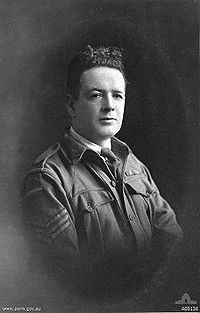- Maurice Buckley
-
Maurice Vincent Buckley
Studio portrait of M. V. BuckleyBorn 13 April 1891
Melbourne, VictoriaDied 27 January 1921 (aged 29)
Melbourne, VictoriaAllegiance  Australia
AustraliaService/branch Australian Imperial Force Years of service 1914–1919 Rank Sergeant Battles/wars - Western Front
- Battle of the Hindenburg Line
Awards Victoria Cross
Distinguished Conduct MedalMaurice Vincent Buckley VC, DCM (13 April 1891 – 27 January 1921) was an Australian soldier serving under the pseudonym Gerald Sexton who was awarded the Victoria Cross during the First World War. This is the most prestigious award for gallantry in the face of the enemy that can be awarded to British and Commonwealth forces.
Contents
Life
Buckley was born at Upper Hawthorn, Melbourne, Australia, to Timothy Buckley, brickmaker, and his wife Agnes, née Sexton. His father was a native of Cork, Ireland; his mother was Victorian-born. Maurice Buckley was educated at the Christian Brothers’ School in Abbotsford. He joined the 13th Light Horse Regiment on 18 December 1914 shortly after the outbreak of the First World War at Warrnambool, Victoria, but found himself discharged in September the following year "declared a deserter, 20 March 1916, and struck off strength".[1]
On 6 May 1916 he enlisted again, this time in Sydney, using the name Gerald Sexton — his brother’s first name and his mother's maiden name. He was sent to France in early 1917 where he fought on the Western Front. Following the award of the Distinguished Conduct Medal he was promoted to sergeant in August 1918 and involved in the advance on the Hindenburg Line. The award of the VC was originally gazetted under the pseudonym Gerald Sexton, but he had disclosed his real identity by the time that it was given to him by King George V at a ceremony at Buckingham Palace on 29 May 1919.[2] and was discharged in December 1919.
Death
He was severely injured in a riding accident at Boolarra, Gippsland on 15 January 1921, and died on 27 January, aged 29. Ten Victoria Cross recipients were pallbearers at his funeral; he is buried at Brighton Cemetery in Melbourne. He was unmarried.
Details
He was awarded the Victoria Cross for his actions on 18 September 1918, at Le Verguier near St. Quentin. His unit was advancing under cover of a creeping barrage but was held up by German machine gun posts. Buckley attacked them with his Lewis gun section and captured 30 German prisoners of war. When the advance was again held up by machine-gun fire, Sergeant Buckley, supported by another platoon, put the enemy guns out of action. Later, he again showed conspicuous initiative in capturing hostile posts and machine-guns. According to the citation, he was “to the fore dealing with enemy machine-guns, rushing enemy posts, and performing great feats of bravery and endurance without faltering or for a moment taking cover.[1]
Medals
His Victoria Cross is displayed at the Australian War Memorial (Canberra, Australia).
Medals: Victoria Cross, Distinguished Conduct Medal, 1914-15 Star, British War Medal, Victory Medal[3]
References
- ^ a b Buckley profile, AIF Project
- ^ National Archives of Australia, pp. 40,90
- ^ Gerald SEXTON, The AIF Project,
Sources
- Monuments to Courage (David Harvey, 1999)
- The Register of the Victoria Cross (This England, 1997)
External links
- D. M. Horner, Profile of Maurice Vincent Buckley (1891 - 1921), Australian Dictionary of Biography, Volume 7, Melbourne University Press, 1979, p. 475
- Service record - Maurice Buckley, National Archives of Australia
- Maurice BUCKLEY, The AIF Project
- Gerald SEXTON, The AIF Project
- Maurice Vincent Buckley (1891-1921)'s gravesite at Brighton General Cemetery (Victoria)
Categories:- 1891 births
- 1921 deaths
- Military personnel from Melbourne
- Australian World War I recipients of the Victoria Cross
- Australian Army soldiers
- Recipients of the Distinguished Conduct Medal
- Australian people of Irish descent
Wikimedia Foundation. 2010.

